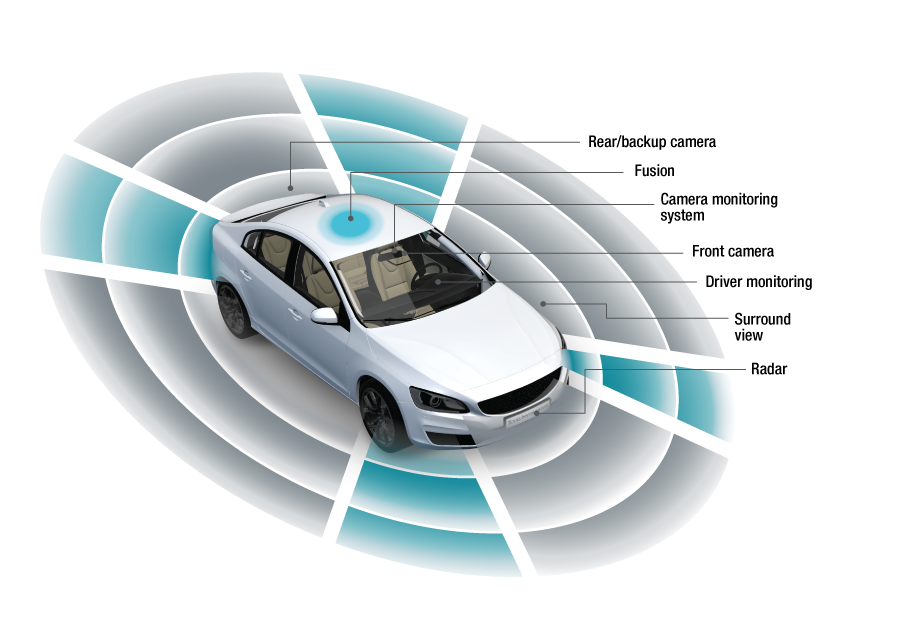-
Making ADAS Technology More Accessible in Vehicles SSZT355 january 2020 DRA829J , DRA829J-Q1 , DRA829V , DRA829V-Q1 , TDA4VM , TDA4VM-Q1 , TPS6594-Q1
-
Making ADAS Technology More Accessible in Vehicles
Making ADAS Technology More Accessible in Vehicles
Curt Moore

Advanced driver assistance system (ADAS) features have been proven to reduce accidents and save lives. According to Consumer Reports, the Insurance Institute for Highway Safety shows that there were 50% fewer front-to-rear crashes with vehicles equipped with forward-collision warning and automatic emergency braking technology compared to cars without these systems in 2017. Tragically, most accidents happen to drivers whose cars are not equipped with even the simplest ADAS applications.
As ADAS continues to evolve there’s an opportunity to make a greater impact on the road by creating ADAS technology that can be used in a wider range of cars.
Although it is not economically practical for all cars to have all ADAS technology, the objective should be to make driving assistance features available in as many cars as possible. This means that more vehicles on roads need to be capable of cost-effectively sensing, processing and acting on real-time data.
The need for smart and diverse sensing
Feature-based computer vision algorithms have traditionally handled the analysis of image data collected for ADAS operations. Computer vision has served the industry well over the last decade, but as ADAS operations become more advanced, designers need additional tools to handle and adapt to situations that drivers and their vehicles face on the road.
Maintaining consistent ADAS operations in all situations is challenging. Unanticipated scenarios like the sudden onset of inclement weather or unsafe road conditions require vehicles to adapt in real-time. These are not scenarios you can code for, but by developing a dynamic system that can help the car sense, interpret and react quickly to the world around it, cars can act more like a co-pilot for the driver. Such a system requires data and the ability to process that data in real-time using a combination of computer vision and efficient deep learning neural networks.
ADAS solutions need to extract data from a diverse sensor set and convert the data to actionable intelligence for the vehicle. At a minimum, these sensors include different types of cameras and associated optics, radars and ultrasonic technology. More complex cases will also include LiDAR and thermal night vision. Further, the system may perform vehicle localization by comparing features extracted from sensor data with high-definition map data. Assimilating and analyzing this multimodal sensor data must happen in real-time – new data arrives 60 times per second – without replacing the backseat of a car with a data-center server.
| Enhance automated parking with Jacinto™ processors. | |

|
 Learn more.
Learn more.
|
Any solution must be road-ready
In the same way that a driver receives multiple inputs concurrently and must make a safe driving decision quickly, any ADAS application — no matter what the level of autonomy – must do the same. A high-performance system on chip (SoC) that can handle concurrent processing without blowing the budget in terms of power, heat, component and integration costs is highly desirable. An SoC solution can scale from more simple cases (fewer sensors, lower resolutions) to the most complex cases without compromising basic ADAS features or requiring a lower-end system.
Meeting application performance across a vehicle lineup is only one requirement. For wide deployment, these systems must be developed cost-effectively. Software complexity is increasing exponentially in vehicles – it is already 150 million lines of code – which is exploding development and maintenance costs. As systems become more situationally aware, safety requirements will evolve and grow, and all of these systems must meet strict automotive quality and reliability targets. These are the exacting demands and realities of supporting the automotive electronics market.
The right SoC addresses all of these demands. It can properly balance memory, inputs/outputs and processing cores against a range of application demands, helping meet system bill-of-materials targets. The right SoC can also accommodate an open software development methodology, making it possible to reuse the resulting code and preserve efforts made in development and testing. An SoC can also be built from the beginning with functional safety as an imperative and with the reliability and product longevity necessary to keep vehicle lines viable in the market for years. Done well, the vision of enabling more cars with robust ADAS features (like those shown in Figure 1) is within reach.
 Figure 1 Examples of ADAS applications
Figure 1 Examples of ADAS applicationsHow TI is helping democratize ADAS technology
TI worked to address sensing, concurrent operation and system-level challenges by leveraging our decades of automotive and functional safety expertise to design our Jacinto 7 processor platform.
We focused on what matters to the entire system: combining outstanding sensing capabilities that monitor a car’s surroundings in multiple directions, and using an automotive-centric design methodology for optimized power and system cost.
The new Jacinto 7 processor family, including the TDA4VM and DRA829V, integrates key functional safety features on-chip that enable both safety-critical and non-safety-critical functions on one device; they also improve data management by incorporating high-speed and automotive interfaces. Jacinto 7 processors bring real-world performance to automotive ADAS and gateway systems and help lower system costs to help democratize ADAS technology and make it more accessible.
IMPORTANT NOTICE AND DISCLAIMER
TI PROVIDES TECHNICAL AND RELIABILITY DATA (INCLUDING DATASHEETS), DESIGN RESOURCES (INCLUDING REFERENCE DESIGNS), APPLICATION OR OTHER DESIGN ADVICE, WEB TOOLS, SAFETY INFORMATION, AND OTHER RESOURCES “AS IS” AND WITH ALL FAULTS, AND DISCLAIMS ALL WARRANTIES, EXPRESS AND IMPLIED, INCLUDING WITHOUT LIMITATION ANY IMPLIED WARRANTIES OF MERCHANTABILITY, FITNESS FOR A PARTICULAR PURPOSE OR NON-INFRINGEMENT OF THIRD PARTY INTELLECTUAL PROPERTY RIGHTS.
These resources are intended for skilled developers designing with TI products. You are solely responsible for (1) selecting the appropriate TI products for your application, (2) designing, validating and testing your application, and (3) ensuring your application meets applicable standards, and any other safety, security, or other requirements. These resources are subject to change without notice. TI grants you permission to use these resources only for development of an application that uses the TI products described in the resource. Other reproduction and display of these resources is prohibited. No license is granted to any other TI intellectual property right or to any third party intellectual property right. TI disclaims responsibility for, and you will fully indemnify TI and its representatives against, any claims, damages, costs, losses, and liabilities arising out of your use of these resources.
TI’s products are provided subject to TI’s Terms of Sale (www.ti.com/legal/termsofsale.html) or other applicable terms available either on ti.com or provided in conjunction with such TI products. TI’s provision of these resources does not expand or otherwise alter TI’s applicable warranties or warranty disclaimers for TI products.
Mailing Address: Texas Instruments, Post Office Box 655303, Dallas, Texas 75265
Copyright © 2023, Texas Instruments Incorporated